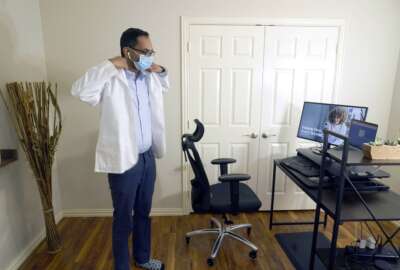
How telehealth became a proven commodity for Medicare recipients
Some 28 million people on Medicare used telehealth in the first year of the pandemic, according to the Department of Health and Human Services.
Best listening experience is on Chrome, Firefox or Safari. Subscribe to Federal Drive’s daily audio interviews on Apple Podcasts or PodcastOne.
A new and impressive statistic has emerged from the pandemic. Everyone knew that remote medical visits or telehealth grew when people could not or were afraid to visit health providers in person. Now the Department of Health and Human Services Office of Inspector General has quantified it for one large section of the population. Some 28 million people on Medicare used telehealth in the first year of the pandemic. For more of what they found and why it’s important, the Assistant IG Erin Bliss spoke to the Federal Drive with Tom Temin.
Interview transcript:
Tom Temin: Ms. Bliss, good to have you on.
Erin Bliss: So happy to be here, Tom. Thank you.
Tom Temin: And just to set the scene here. This is one of several studies you have been doing of pandemic health care delivery by Medicare and Medicaid services throughout this whole deal we’ve been through.
Erin Bliss: Yes, that’s right. This report is part of a much larger portfolio of OIG work on telehealth and it’s also the first in a series of three evaluations specifically analyzing use of telehealth and Medicare during the first year of the pandemic, or from March 2020 through February 2021. So this first report provides the landscape overview of what that telehealth use looks like. The second report delves into which groups of Medicare beneficiaries use telehealth the most to access care, and how do they access that care. And the third evaluation focuses on provider billing that may present program integrity risks.
Tom Temin: All right, and telehealth was generally paid for or not paid for by Medicare before the pandemic?
Erin Bliss: Before the pandemic, Medicare coverage of telehealth was very limited. For example, beneficiaries in rural areas were allowed to use telehealth for some service types but had to access those services from medical facilities. They couldn’t use it from their homes. In the year prior to the pandemic, less than 1% of Medicare beneficiaries received any services via telehealth.
Tom Temin: All right and so this 28 million that did, I think your report said is one out of five?
Erin Bliss: Yes, actually just over two out of five. COVID-19 changed everything about health care delivery, created unprecedented challenges for how Medicare beneficiaries and others accessed health care. And so Congress and the Centers for Medicare and Medicaid Services (CMS) took a number of actions to temporarily open up access to telehealth for Medicare beneficiaries. So CMS allowed beneficiaries to use telehealth for a wider range of services and in different locations, including from their home and for beneficiaries in urban areas.
Tom Temin: And give us some of the other statistics you found. I mean, 28 million, what do they generally for example, use telehealth for or was it everything you would ordinarily go to the doctor for?
Erin Bliss: It was and in fact, office visits, which are basically routine appointments with your primary or specialty care provider did account for the largest amount of telehealth services. But what really stood out was the way beneficiaries use telehealth to access behavioral health care. So 43% of all behavioral health services were provided through telehealth and this was far more than other types of services. So those office visits were only provided through telehealth about 13% of the time. So telehealth was really crucial in meeting the rising mental health and substance use disorder needs that emerged during the pandemic.
Tom Temin: Yeah, so for example, psychotherapy or talk therapy type of thing where people might even have been more effective, for all we know, under under the tele- situation as opposed to sitting in a chair somewhere.
Erin Bliss: Exactly. There are other barriers even beyond the pandemic for seeking in-person care sometimes for people suffering from mental health issues or behavioral health issues. So individual therapy, group therapy, substance use disorder treatment were accessed through telehealth much more frequently than other types of services.
Tom Temin: We’re speaking with Erin Bliss, she’s the assistant inspector general at the Health and Human Services Department. And so what can CMS take away from this? Well, let’s begin with what is the status of payment for telehealth now? As you mentioned earlier, that was a temporary fix that Congress and HHS agreed to, because it was expediency. Now we know that it works. And so is it a permanent part of the Medicare system?
Erin Bliss: Not yet. So Congress is considering multiple bills that would be aimed at expanding access to telehealth for the long term and recently extended many of the current telehealth flexibilities for five months after the end of the public health emergency. So we see this report as providing important information for both Congress and CMS as they continue to figure out in a way, what types of changes to make to the permanent telehealth policy and Medicare. They’re balancing concerns around access, quality, equity and program integrity.
Tom Temin: Right. I guess the key here is does CMS have the tools in place to evaluate that they are getting the quality care they’re paying for when it’s a tele- situation. Is that really where the crux of this whole question lies?
Erin Bliss: That’s a very important dimension, making sure that the beneficiaries are receiving the care that they need of the quality that they need and the value that we’re paying for. But yeah, the issues of quality, the issues of access and the issues of program integrity and making sure that providers aren’t taking advantage of telehealth to defraud the system are all incredibly important considerations. And so CMS and Congress where legislative authority is needed, are trying to weigh all those different factors they so this current report provides information about what types of services were being used, how many beneficiaries were accessing them. It’s interesting to know that even though we had this huge uptick in the use of telehealth, overall, beneficiary still received most of their health care in person. So telehealth only accounted for 12% of the total health care services during that first year of the pandemic. So our findings illustrate how telehealth might fit into that larger picture of health care delivery. For behavioral health telehealth became an essential way that beneficiaries access their care. But for other services, telehealth just helped beneficiaries access care when they face certain barriers, but most of their care remained in person and with their pre-existing providers.
Tom Temin: Sure, I guess well, if you have a condition that requires being touched by a practitioner or an instrument than you really got to be there. So far, there’s no way to do that robotically. And what’s your sense of what CMS thinks? I mean, how do they take the report? You didn’t really have recommendations. You found a lot of facts about all of this, What happens next for CMS?
Erin Bliss: Exactly, well CMS is very actively weighing its policy options and determining what it should do moving forward. We hope that this information will help provide them useful insights. As I mentioned earlier, this is part of a larger series and so our upcoming reports that focus on which beneficiaries are using telehealth and in what ways, which has implications for access and for equity, as well as program integrity risks associated with certain telehealth providers. We anticipate that we’ll have recommendations for CMS coming out of those reports.
Tom Temin: Yes because program integrity is a big ongoing forever issue for CMS because it’s the largest payer of improper payments and some of those sensational cases come to light once in a while. And I guess you don’t want those for telehealth.
Erin Bliss: Exactly. Program integrity is an issue across the board for in person care as well as for remote care options. It is important, though, to distinguish between telehealth fraud, which is fraud involving billing for a telehealth service itself, and something that we refer to as “tele-fraud,” which is really the use of a telemarketing type tactic to commit basically traditional bread and butter fraud. So in recent years, OIG has had several large, publicized investigations of telefraud, where perpetrators were basically cold calling beneficiaries conducting a sham visit over the phone, and then ordering unnecessary medical equipment or genetic tests. The fraud in those cases was aimed at the unnecessary billing for the equipment and the tests. For the most part, they were actually billing for the fake telehealth phone call.
Tom Temin: Right, okay. They are certainly creative out there, aren’t they, the fraudsters?
Erin Bliss: Absolutely. And that scam even preceded the pandemic but unfortunately, has continued.
Tom Temin: All right, well, that next report will have you back for that one. Erin Bliss is assistant inspector general at the Health and Human Services Department. Thanks so much for joining me.
Erin Bliss: Thank you, Tom. Appreciate the opportunity.
Copyright © 2025 Federal News Network. All rights reserved. This website is not intended for users located within the European Economic Area.
Tom Temin is host of the Federal Drive and has been providing insight on federal technology and management issues for more than 30 years.
Follow @tteminWFED




